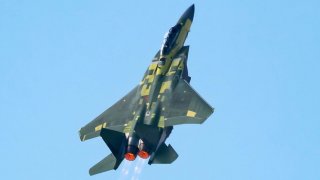Boeing's F-15EX: The U.S. Air Force's Biggest Mistake Ever?
Simply put, the F-15EX is not survivable against the modern surface-to-air and air-to-air weapons of great powers like Russia and China.
The U.S. Air Force (USAF) has signed a contract to acquire over 140 F-15EX fighters; the first model arrived earlier this month, with two more due in April. But the colossal procurement is one of USAF’s most poorly considered acquisitions in recent years--a cost-ineffective investment into an increasingly outdated style of warfare.
F-15EX, Explained
The Boeing F-15EX is the latest variant of the F-15E Strike Eagle, which itself is based on the 1972 F-15 Eagle. The EX upgrade package offers several improvements over the original model, including a better radar, new avionics, and a revised cockpit display.
These minor improvements notwithstanding, the fact remains that the EX is based on a roughly forty-five-year-old airframe. The F-15 Eagle was once one of the best fighters in its class, but aircraft design-- and, with it, anti-air weaponry--has advanced by leaps and bounds since the 1970s.
As a fourth-generation fighter, the F-15EX utterly lacks the stealth features necessary to operate effectively in the context of modern air combat. Simply put, the F-15EX is not survivable against the modern surface-to-air and air-to-air weapons of great powers like Russia and China. With the ongoing global proliferation of Russia’s formidable S-400 missile system and the imminent debut of its S-500 successor, it will become progressively harder for F-15EX squadrons to fly in contested airspace without incurring active risks.
Even older weapons like North Korea’s KN-06 surface-to-air missile system (SAM) can feasibly threaten the F-15EX if not suppressed or otherwise neutralized beforehand. By the time that most F-15EX’s enter service over the coming decade, these design shortcomings will become even more of a liability than they currently are.
A Plane Built for the Cold War, Not the 21st Century
However, argue its proponents, what the F-15EX lacks in survivability, it makes up for with sheer firepower. It is undeniably true that the F-15EX boasts a prodigious armament suite; with its new Advanced Missile and Bomb Ejection Rack (AMBER) system, the fighter is capable of carrying as many as twenty-two onboard air-to-air missiles.
Sure, that sounds very appealing, but we need to separate hype from the realities of modern warfare. First, it hardly matters how many missiles the F-15EX can carry if it doesn’t survive long enough to use them.
Secondly, it’s worth noting that the F-35 can carry a similarly impressive sixteen missiles in its “third day of war”--also known as “beast mode”--configuration. What practical battlefield tasks can be accomplished with twenty-two missiles that can’t be accomplished with sixteen missiles? It is difficult to conceive of a remotely likely scenario in which the F-15EX would both need, and be able to, unload its entire payload.
Further still, the F-35 offers far greater operational versatility by being able to swap between stealth and external configurations depending on the mission type. While impressive on paper, the F-15EX’s weapons capacity seems more like a gimmick than a practical battlefield feature-- an exaggerated solution in search of a contrived problem.
New battlefield challenges call for fundamentally new technical solutions like stealth performance and deep penetration capabilities. The F-15EX platform does not, and cannot, provide the USAF with a sound foundation for sustainable growth. As Washington’s great-power competitors and regional rivals continue to procure increasingly more sophisticated anti-air capabilities, it makes little financial or military sense to invest in the capabilities of a bygone era.
Mark Episkopos is the national security reporter for the National Interest.

